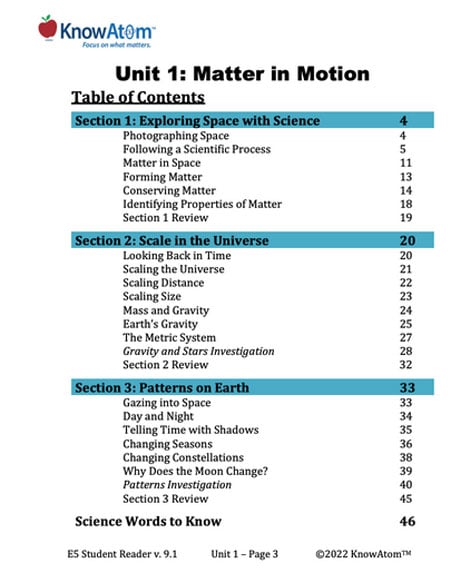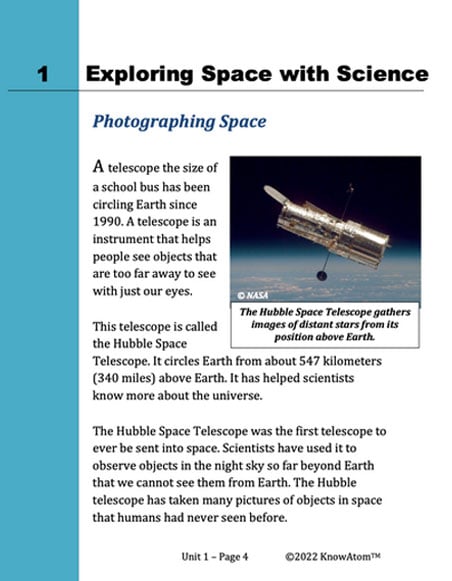Science background gives teachers more in-depth information about the phenomena students explore in this unit. Here is an excerpt from the science background information on patterns in the solar system.
From Earth, it appears as though our planet is stationary, while the sun, moon, and stars travel around it. The sun appears to rise in the east and set in the west; the moon seems to travel across the night sky; and the constellations appear in different places depending on the time of year. These movements result in patterns that people have used to mark the passage of time.
The movement of the sun across the sky marks a day, and the length of the day and night determines the seasons. The changes of the moon mark the passage of a month. The presence of specific stars in the night sky also changes over the course of the year.
However, scientists know that Earth itself is in constant motion. Earth and the other planets orbit the sun, while the moon orbits Earth. At the same time, Earth is also rotating, which means it spins like a top. Earth rotates on an imaginary line that goes from the North Pole to the South Pole, called an axis.
Every hour, Earth rotates on its axis at a speed of 1,600 kilometers (1,000 miles). The reason we don’t feel like we’re speeding through air is similar to how it can feel in an airplane like the plane isn’t moving. Gravity holds us all onto the planet, and so we rotate with it.
We can look to the apparent movement of the Sun, Moon, planets, and stars to see evidence of Earth’s movement. All of these bodies appear to rise in the east and set in the west over the course of one day because Earth completely rotates around its axis about once every 23 hours and 56 minutes (one Earth day). As Earth rotates, part of the planet gets light, and then dark. The Sun always shines, but its light only hits one half of Earth at a time. This is why we have day and night.
As the Sun rises in the east, it casts shadows that change over the course of a day. Shadows are dark shapes created when an object blocks light.
The length of the shadow depends on how low or high the Sun is in the sky. For example, when the Sun shines down from directly above you, your head is the only part of your body blocking the sunlight. As a result, there is very little shadow. This is why in the middle of the day, around lunchtime, your shadow will become very small. It might even disappear. In contrast, your shadow will be the largest when the sun is near the horizon because more of your body is blocking the sun’s light.
The formation of shadows is so predictable that ancient people used shadows to make the world’s first clock—a sundial. Sundials generally tell time by casting a shadow or throwing light onto a surface. The surface usually is marked with hour lines, so the place where the shadow or light falls indicates the time.
Ancient people also used shadows to mark the passage of a year. They could do this because the length and direction of shadows changes depending on the time of year.
The shadows change because of Earth’s position relative to the sun as it orbits. Earth’s axis is tilted slightly, at a 23.5-degree- angle. It is Earth’s tilt, not its distance from the sun, that causes the different seasons. A season is a period of time characterized by specific weather patterns and by the length of day and night. Seasons repeat over and over, year after year, as Earth orbits the sun.
Because of Earth’s tilt, the northern and southern hemispheres each receive different amounts of sunlight. For half of the year, Earth is tilted toward the sun. When this happens, it is summer in the north and winter in the south. For the other half of the year, Earth is tilted away from the sun.
Earth’s tilted axis is also the reason why there are more hours of daylight in the summer and fewer hours of daylight in the winter. In the winter, the days are shorter the closer you are to the North Pole. At the North Pole, it is dark all winter long, with no daylight. In the summer, the days are longer the closer you are to the North Pole. At the North Pole in the summer, it is day all the time.










